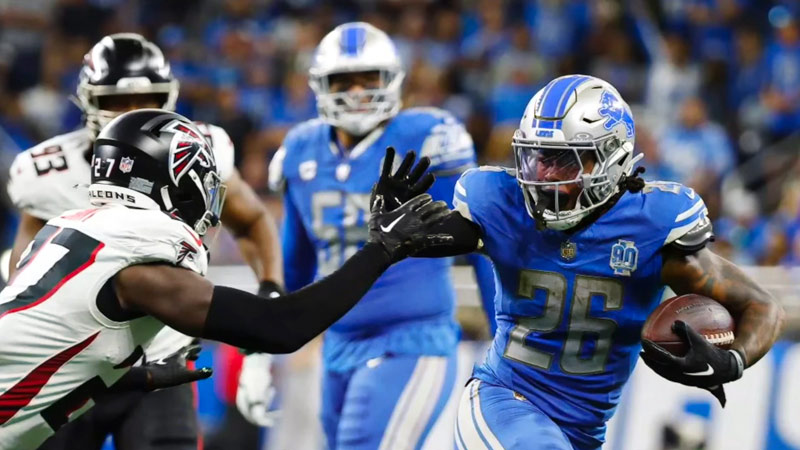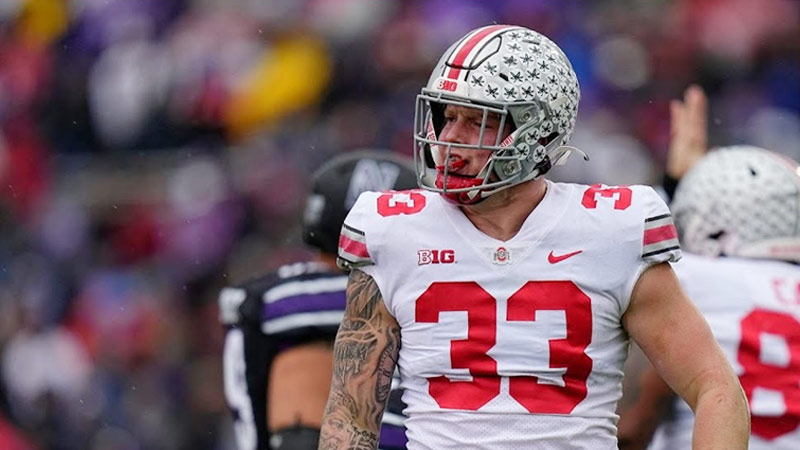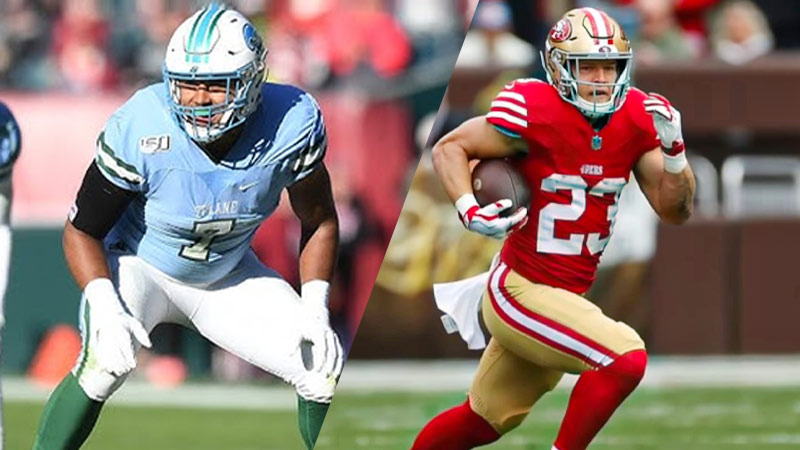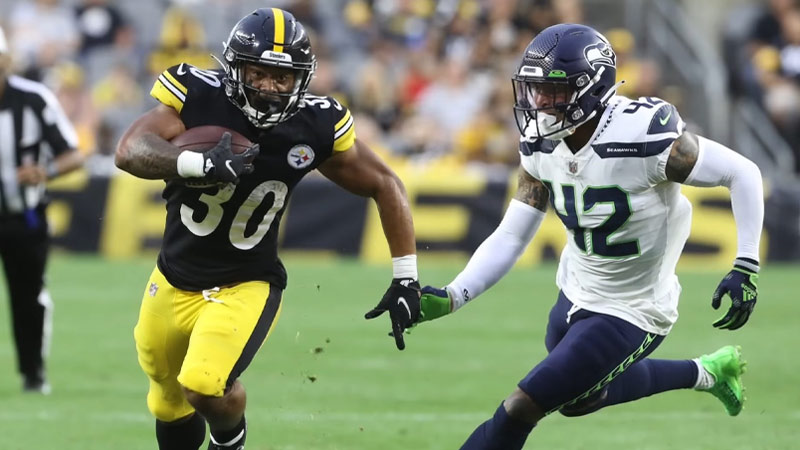In the intricate tapestry of football, every position has a distinct role, and one term that often finds its way into football discussions is “the edge.” Understanding what “edge” means in the context of football is pivotal for fans, players, and coaches alike.
The “edge” in football refers to the outermost perimeter of the field, particularly the area near the sideline. This seemingly simple term, however, holds profound significance in the sport’s strategy and execution.
On offense, teams strive to gain an advantage by exploiting the edge, employing plays designed to outflank the defense, while on defense, players are tasked with maintaining the integrity of the edge, preventing ball carriers from breaking free.
The edge represents a boundary, a point of attack, and a line of defense all at once. This exploration delves into what is an edge in football, shedding light on its importance and the strategies associated with this vital aspect of the game.
What Is An Edge In Football?
In football, “the edge” refers to the outermost perimeter of the field, particularly the area near the sideline. It is a crucial aspect of both offensive and defensive strategies.
On offense, teams often aim to exploit the edge by running plays like sweeps, tosses, or pitches, where a ball carrier, usually a running back or a wide receiver, attempts to reach the sideline and turn upfield to gain yards.
These plays take advantage of the potential for open space on the edge and the opportunity to outmaneuver defenders.
Defensively, “setting the edge” is a term used to describe the role of players, typically linebackers or defensive ends, who are responsible for preventing ball carriers from getting outside and turning up the field.
They maintain outside leverage to force the play back toward the center of the field, ensuring that the offense cannot gain significant yardage by exploiting the sideline.
Controlling the edge is critical for defensive containment and minimizing big plays. Thus, understanding and effectively utilizing the edge is a fundamental aspect of football strategy on both sides of the ball.
What Position In Football Is Called Edge?
The term “edge” in football primarily refers to two defensive positions: the defensive end (DE) and the outside linebacker (OLB) in certain defensive schemes.
Here’s a description of these positions and five others sometimes associated with the “edge” role:
Defensive End (DE)

Defensive ends are typically found on the defensive line and play a crucial role in rushing the passer and defending against running plays. They line up on the outermost edge of the defensive line, often tasked with pressuring the quarterback and containing outside runs.
Their combination of size, strength, and speed is essential in disrupting offensive plays on the edge.
Outside Linebacker (OLB)
In certain defensive schemes, outside linebackers are positioned on the edge. They are versatile players responsible for both pass coverage and pass rushing.
OLBs must effectively set the edge against runs, rush the passer, and sometimes drop into coverage to defend against passes, making them key playmakers in many defensive formations.
Cornerback (CB)
Cornerbacks are defensive backs who often align on the edge, near the sideline. They are primarily responsible for covering wide receivers and preventing them from making receptions.
Corners must use their speed and agility to stay with receivers, making it challenging for the offense to complete passes along the edge of the field.
Safety (S)
Safeties, particularly strong safeties (SS), play a significant role in defending the edge against both the run and the pass. They are the last line of defense and must be sure tacklers when ball carriers or receivers reach the edge, preventing big gains and potential touchdowns.
Wide Receiver (WR)
On the offensive side, wide receivers often line up on the edge. They are primary targets for quarterbacks in passing plays, using their speed and route-running abilities to get open and catch passes along the sideline, exploiting the edge of the field to gain yards.
Running Back (RB)
Running backs can be involved in plays designed to exploit the edge. They use their agility and speed to turn the corner and gain yards along the sideline, making them valuable weapons in running and receiving plays along the edge.
Tight End (TE)
Tight ends are versatile offensive players who can line up on the edge of the offensive line. They are valuable in both blocking and receiving roles, often used to seal the edge for running plays or as pass-catching options along the sideline in short to intermediate passing routes.
Understanding the roles and responsibilities of these positions on the edge of the field is essential for effective football strategy on both offense and defense.
Each position contributes to the overall success of their respective units and can have a significant impact on the outcome of a game.
Which Players Make Good Edge Rushers?

There are many players who make good edge rushers in the NFL, but here are some of the best ones based on their performance:
Myles Garrett, Cleveland Browns
Garrett is arguably the best edge rusher in the league right now, leading the NFL with 16 sacks and 32 quarterback hits through Week 14.. He also has four forced fumbles, two fumble recoveries, and a touchdown.
Garrett is a physical freak who combines speed, power, and technique to dominate offensive tackles and disrupt quarterbacks.
T.J. Watt, Pittsburgh Steelers
Watt is the reigning Defensive Player of the Year and a strong candidate to repeat the award this season. He has 15.5 sacks, 25 quarterback hits, six forced fumbles, and three fumble recoveries in 11 games.
Watt is a relentless and versatile pass rusher who can win with speed, power, finesse, or coverage skills.
Khalil Mack, Los Angeles Chargers
Mack is one of the most consistent and productive edge rushers in the league, having recorded at least eight sacks in each of his eight seasons. He has ten sacks, 18 quarterback hits, four forced fumbles, and two fumble recoveries this season.
Mack is a force against both the pass and the run, using his strength, agility, and instincts to make plays.
Micah Parsons, Dallas Cowboys
Parsons is a rookie sensation who has emerged as one of the best defensive players in the league. He has 12 sacks, 18 quarterback hits, three forced fumbles, and two fumble recoveries in 13 games.
Parsons is a hybrid defender who can play as an off-ball linebacker or as an edge rusher, generating pressure from various alignments and angles.
Joey Bosa, Los Angeles Chargers
Bosa is a perennial Pro Bowler who has been one of the most disruptive edge rushers in the league since his rookie year in 2016. He has nine sacks, 23 quarterback hits, three forced fumbles, and a fumble recovery this season.
Bosa is a technician who uses his hands, leverage, and quickness to beat blockers and get to the quarterback.
Maxx Crosby, Las Vegas Raiders
Crosby is a breakout star who has taken his game to another level this season. He has eight sacks, 28 quarterback hits, four forced fumbles, and two fumble recoveries in 14 games.
Crosby is a high-motor and high-effort player who never gives up on a play and creates havoc with his speed and energy.
Nick Bosa, San Francisco 49ers
Bosa is a comeback player who has bounced back from a torn ACL that sidelined him for most of the 2020 season. He has 14 sacks, 21 quarterback hits, three forced fumbles, and a fumble recovery in 14 games.
Bosa is a powerful and explosive pass rusher who can overwhelm blockers with his strength and burst.
What Is The Difference Between A Defensive End And An Edge?

In football, the terms “defensive end” and “edge” are often used interchangeably, but they can have nuanced differences depending on the defensive scheme and team philosophy.
Here are some key differences between a defensive end and an edge player:
Positional Alignment
- Defensive End: Defensive ends typically line up as part of the defensive line, either as a 4-3 defensive end in a four-man front or as a 3-4 defensive end in a three-man front.
- Edge: The term “edge” is more of a broad descriptor that encompasses players positioned on the outermost edge of the defense, including both defensive ends and outside linebackers in various defensive formations.
Primary Responsibilities
- Defensive End: The primary role of a defensive end is to disrupt plays in the backfield, contain running backs, and rush the passers, using their size, strength, and speed to do so.
- Edge: An edge player may have a more versatile role, as it can refer to both defensive ends and outside linebackers. Edge players are often responsible for setting the edge on runs, rushing the passer, and dropping into coverage in certain defensive schemes.
Defensive Scheme
- Defensive End: Typically associated with 4-3 or 3-4 defensive schemes, where they have a defined role along the defensive line.
- Edge: The term “edge” is more inclusive and is used in a broader context to describe players on the perimeter of the defense, regardless of the specific scheme.
Pass Rush Techniques
- Defensive End: Defensive ends primarily focus on pass-rushing techniques such as bull rushes, speed rushes, and using their hands to disengage from blockers.
- Edge: Edge players can encompass a wider range of pass-rushing techniques, as they may need to drop into coverage and read plays before rushing the quarterback.
Alignment Variations
- Defensive End: Defensive ends often align with their hands in the dirt on the line of scrimmage, allowing them to engage with offensive linemen more effectively.
- Edge: Edge players may align in a standing position as outside linebackers in some schemes, giving them a better view of the field and enabling them to drop into coverage more easily.
Physical Attributes
- Defensive End: Defensive ends are typically larger and more powerful, as they often need to engage with offensive tackles and tight ends in the trenches.
- Edge: Edge players can vary in size and athleticism, with outside linebackers often possessing more speed and agility to cover pass-catching targets.
Coverage Responsibilities
- Defensive End: Defensive ends are rarely involved in pass coverage and are primarily focused on stopping the run and rushing the passer.
- Edge: Edge players, particularly outside linebackers, may have coverage responsibilities, including covering tight ends or dropping into zones in pass coverage schemes.
While the terms “defensive end” and “edge” both pertain to players who play on the outer edges of the defense, “defensive end” is more specific to players on the defensive line in certain schemes, whereas “edge” is a broader descriptor that can encompass both defensive ends and outside linebackers who fulfill various roles in different defensive systems.
FAQs
What is the “edge” in football?
The “edge” in football refers to the outermost perimeter of the field, particularly the area near the sideline. It’s a critical concept in the sport, influencing offensive and defensive strategies.
Why is the edge important in football?
The edge is vital because it represents a point of attack and defense. Offensively, it’s a potential avenue for gaining yardage, while defensively, it’s a boundary that defenders aim to protect.
How do offenses utilize the edge in football?
Offenses use plays like sweeps, tosses, and pitches to exploit the edge. These plays involve ball-carriers attempting to reach the sideline and turn upfield, taking advantage of the open space, and attempting to outrun defenders to gain yards.
What is “setting the edge” on defense?
“Setting the edge” is a defensive technique where players, often outside linebackers or defensive ends, maintain outside leverage to prevent ball carriers from getting outside and turning up the field.
How does the edge impact passing plays in football?
The edge can influence passing plays by providing quarterbacks and receivers with space to operate near the sideline. Receivers can use the edge to their advantage by running routes along the sideline, potentially creating opportunities for completions and big gains.
Conclusion
In the world of football, the concept of the “edge” serves as a pivotal battleground where strategy, athleticism, and execution converge. Its significance extends beyond the physical boundary of the field to encompass the heart of the sport’s tactical depth.
The edge is where offensive creativity meets defensive tenacity, where ball carriers seek to gain yardage, and where defenders aim to deny them.
As football continues to evolve, so too will the strategies surrounding the edge, making it a dynamic and ever-evolving aspect of the game. It’s a testament to the sport’s complexity and the never-ending quest for competitive advantage.
So, whether it’s a running back sprinting to the sideline or a defender fighting to maintain containment, the edge remains a defining feature of football – where games are won and lost and where the sport’s enduring appeal is eternally etched in every play.







